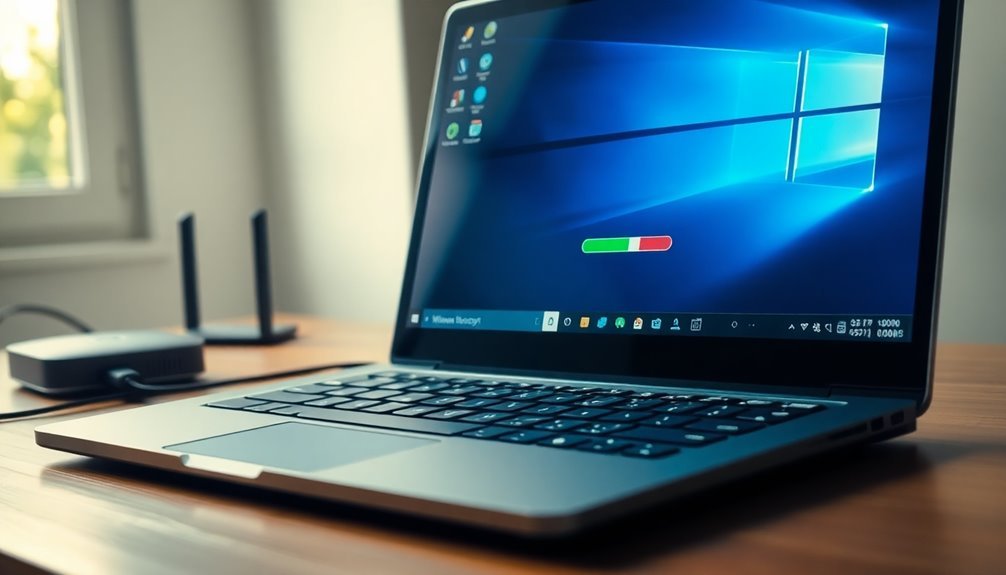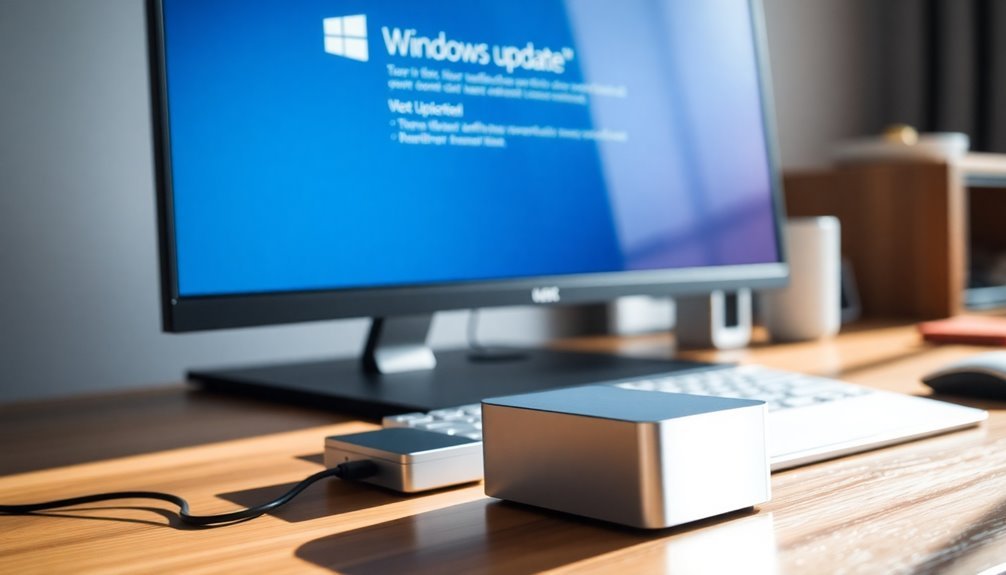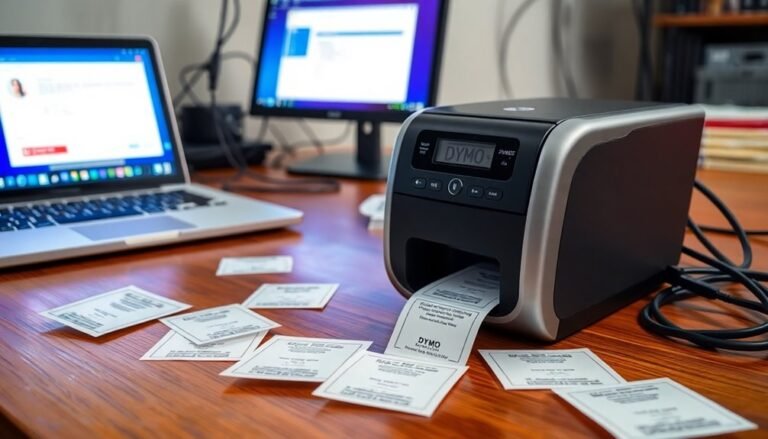Windows Not Working After Update: Fix Post-Update Problems

If Windows isn’t working after an update, start by running the Windows Update Troubleshooter for quick fixes. This tool can identify and resolve common update problems.
Next, use the SFC and DISM commands in Command Prompt to repair corrupted system files. These commands help restore system integrity.
Clear the SoftwareDistribution folder to remove problematic update files. This can resolve issues caused by corrupted downloads.
Free up disk space if updates keep failing. Insufficient space can prevent updates from installing properly.
Try using System Restore to revert changes made by the update. This can undo recent system modifications.
If problems persist, boot into Safe Mode or reset Windows. These options can help address more stubborn post-update issues.
Identifying Common Issues After Windows Updates

Common Windows Update Problems and How to Fix Them
After installing a Windows update, you might experience various issues. To identify what went wrong, start by checking for error codes such as 0x80070002 (missing files), 0x80070005 (access denied), or 0x8024402F (update service problems). These error codes often appear during failed updates and can help diagnose the issue quickly.
If your PC restarts repeatedly or fails to boot, the problem could be caused by update conflicts, incompatible drivers, corrupted files, or power interruptions during the update process. It’s important to note that a restart loop can happen when Windows updates are interrupted or conflicts occur, preventing your PC from booting normally.
Blue Screen of Death (BSOD) errors frequently indicate faulty updates or incompatible hardware drivers.
Display problems like screen flickering, resolution changes, or other visual glitches are commonly related to outdated or incompatible graphics drivers after an update. To resolve these, update or reinstall your graphics drivers.
Experiencing slow performance, frequent crashes, or high CPU and memory usage after a Windows update? These symptoms often point to malfunctioning services or drivers.
Network connectivity issues after an update usually suggest corrupted or outdated network drivers.
Lastly, update failures can occur due to corrupted system files or improper permissions. Running the Windows System File Checker (SFC) tool and checking user access rights can help fix these problems.
Running the Windows Update Troubleshooter
How to Use the Windows Update Troubleshooter to Fix Update Issues
To start, launch the Windows Update Troubleshooter and click Advanced. Ensure the option Apply repairs automatically is selected for seamless issue resolution.
Then, click Next to initiate the scanning process. This powerful tool will detect and attempt to fix common Windows Update problems quickly. The Windows Update Troubleshooter is built into both client and server versions of Windows, making it a convenient solution for most environments.
Once the troubleshooting completes, carefully review the results. If the tool identifies and repairs issues, it’s important to restart your computer to apply the fixes fully.
Should update problems continue, run the Windows Update Troubleshooter again for another diagnostic pass.
For a deeper understanding of the detected issues, click View detailed information. Keep in mind that while the Windows Update Troubleshooter resolves many common errors, some persistent problems may require additional advanced troubleshooting steps.
Checking for Corrupted System Files With SFC
How to Use System File Checker (SFC) to Fix Corrupted Windows System Files
Maintaining your Windows system’s health depends heavily on the integrity of critical system files. The System File Checker (SFC) tool is an essential utility that helps you scan for and repair corrupted or missing Windows system files quickly and easily.
Step-by-Step Guide to Running SFC Scan
1. Open Command Prompt as Administrator:
Click Start, type “cmd,” right-click on Command Prompt, and select “Run as administrator.”
2. Run the SFC Scan:
In the elevated Command Prompt window, type the command `sfc /scannow` and press Enter. This command initiates a thorough scan of all protected system files.
3. Wait for the Scan to Complete:
The scan will automatically detect corrupted or modified files and replace them with a cached copy stored in secure folders like WinSxSBackup (for newer Windows versions) or the System32dllcache folder (for older Windows).
4. Restart Your Computer:
Once the scan reaches 100%, close Command Prompt and reboot your PC to apply any repairs.
What to Do If SFC Finds Issues
- If SFC reports “Windows Resource Protection found corrupt files and successfully repaired them,” your system files are fixed.
- If you see “Windows Resource Protection found corrupt files but was unable to fix some of them,” further manual repair or advanced troubleshooting may be necessary.
- For systems that won’t boot normally, you can run the SFC scan from Windows Recovery Environment (WinRE) using offline scan parameters to specify the Windows directory.
Checking Detailed Logs
For detailed information about the scan and repairs, review the CBS.log file located in `C:WindowsLogsCBSCBS.log`. This log helps diagnose persistent issues after running SFC.
Using the System File Checker (SFC) tool regularly helps maintain your Windows PC’s stability and prevent system errors caused by corrupted files. Follow this guide to ensure your system files are healthy and your Windows operating system runs smoothly.
Repairing Windows Image Using DISM
How to Repair Windows Image Using DISM Tool for Optimal System Health
If the System File Checker (SFC) tool can’t fully repair corrupted Windows files or you continue to experience errors after a Windows update, the DISM (Deployment Image Servicing and Management) tool is your next best solution.
DISM is a powerful Windows utility designed to repair Windows system image corruption, especially when SFC alone is insufficient.
Follow these three essential steps to diagnose and fix Windows image issues effectively:
1. Check for Windows Image Corruption with DISM
Run the command:
`DISM /Online /Cleanup-Image /CheckHealth`
This command quickly checks if the Windows image has any corruption. It only scans and reports issues without making any changes.
2. Perform a Detailed Scan for Corruption****
Execute:
`DISM /Online /Cleanup-Image /ScanHealth`
This deeper scan takes more time but provides a comprehensive status report on the health of your Windows image.
3. Repair Windows Image Using DISM
Run:
`DISM /Online /Cleanup-Image /RestoreHealth`
This command attempts to repair any detected image corruption. If the repair fails, use an external source for repair files by adding:
`/Source:X:Pathinstall.wim /LimitAccess`
Replace `X:Pathinstall.wim` with the path to your Windows installation media or a mounted ISO file.
Pro Tip: After completing DISM repairs, always run `sfc /scannow` to ensure all system files are fully restored and your Windows system runs smoothly.
By regularly using the DISM tool, you can maintain your Windows operating system’s integrity, fix update errors, and improve overall system performance.
For more Windows troubleshooting tips and repair guides, bookmark this page!
Clearing the SoftwareDistribution Folder

How to Clear the SoftwareDistribution Folder to Fix Windows Update Issues
If you’re experiencing persistent Windows Update errors or slow update performance, clearing the SoftwareDistribution folder can help. The SoftwareDistribution folder, located at C:WindowsSoftwareDistribution, temporarily stores Windows update files and metadata. Over time, this folder can become bloated or corrupted, causing update failures or delays.
Follow these simple steps to clear the SoftwareDistribution folder and resolve Windows Update problems:
1. Stop the Windows Update Service
Open Command Prompt as an administrator and run the command:
`net stop wuauserv`
Alternatively, open the Services app (services.msc), find “Windows Update,” and click Stop.
2. Clear the SoftwareDistribution Folder
Navigate to C:WindowsSoftwareDistribution in File Explorer. Delete all files and folders inside. For a safer method, rename the folder to SoftwareDistribution.old.
3. Restart the Windows Update Service
In Command Prompt, enter:
`net start wuauserv`
Or restart the service via the Services app.
After clearing the folder, your Windows Update history will be cleared, but installed updates remain unaffected. The next update check might take longer as Windows downloads new update files.
This proven method is safe and frequently resolves common Windows Update errors, freeing up disk space and improving update performance.
For more Windows troubleshooting tips and updates, stay tuned to our blog and keep your system running smoothly.
Resetting Windows Update Components Manually
How to Manually Reset Windows Update Components to Fix Update Issues
If the Windows Update Troubleshooter doesn’t fix your update problems, manually resetting Windows Update components is an effective next step. This method resolves common issues like corrupted update files, permission errors, and stuck services that prevent Windows updates from installing.
Follow these simple steps to reset Windows Update components on your PC:
Step 1: Stop Windows Update Services
First, open Command Prompt as an administrator. Type the following commands one at a time and press Enter after each to stop essential update services:
“`
net stop bits
net stop wuauserv
net stop appidsvc
net stop cryptsvc
“`
Stopping these services ensures that no update files are in use during the reset process.
Step 2: Rename SoftwareDistribution and Catroot2 Folders
Next, rename the SoftwareDistribution and Catroot2 folders, which store temporary update files. This helps clear corrupted or problematic update data. Run these commands in the same Command Prompt window:
“`
Ren %systemroot%SoftwareDistribution SoftwareDistribution.bak
Ren %systemroot%system32catroot2 catroot2.bak
“`
Step 3: Delete BITS Queue Data and Reset Permissions
To further troubleshoot, delete Background Intelligent Transfer Service (BITS) queue files with this command:
“`
Del “%ALLUSERSPROFILE%MicrosoftNetworkDownloaderqmgr*.dat”
“`
After deleting these files, reset the permissions for BITS and Windows Update services using the `sc.exe sdset` commands (refer to Microsoft documentation for the exact syntax).
Step 4: Restart Your PC
Finally, reboot your computer to apply all changes. After the restart, try running Windows Update again to see if the issue is resolved.
By manually resetting Windows Update components, you can fix stubborn update errors and keep your Windows 10 or Windows 11 system up to date.
For more troubleshooting tips, visit the official Microsoft support site or check out our detailed Windows Update guides.
Freeing Up Disk Space for Successful Updates
How to Free Up Disk Space for Smooth Windows Updates
Ensuring sufficient disk space is crucial for successful Windows updates. Typically, feature updates require 6–11 GB of free space, but major upgrades may need 20–30 GB to store rollback files.
To free up space, start by deleting temporary files with built-in tools like Disk Cleanup or Storage Sense. Focus on clearing Windows Update Cleanup and Delivery Optimization Files for the best results.
Next, uninstall unused programs or large games that consume significant storage. Move personal files such as photos, videos, and documents to external drives to free up more space.
Remember to empty the Recycle Bin to recover additional disk space.
If disk space is still limited, connect an external USB drive or SD card with at least 10 GB free; Windows will automatically prompt you to use it for temporary update files.
Configure Storage Sense to run automatic cleanups and regularly remove unnecessary files to maintain optimal storage.
Always back up important data before performing major cleanups to prevent accidental loss.
Following these effective disk space management tips will help you avoid Windows update errors related to insufficient storage and ensure a smooth update experience.
Using System Restore to Undo Problematic Updates
How to Use System Restore to Fix Issues After Windows Updates
If you’ve cleared space for Windows updates but still encounter problems after installing them, using System Restore can help. System Restore allows you to undo recent changes by reverting your Windows system to a previous state before the update was installed. It creates restore points—snapshots of system files, drivers, and registry settings—without affecting your personal documents or files.
Follow these simple steps to use System Restore and fix update-related issues:
- Open System Restore: Click the Windows search bar, type “Restore,” select “Recovery,” and then click “Open System Restore.”
- Select a Restore Point: Choose a restore point dated before the problematic update occurred. If you don’t see the desired point, click “Show more restore points.” You can also click “Scan for affected programs” to see which apps and drivers will be changed.
- Confirm and Restart: After selecting the restore point, click “Finish” to start the restoration process. Your PC will restart and restore your system to the chosen state.
Keep in mind, System Restore will only work if valid restore points exist and aren’t corrupted. If you use BitLocker encryption, have your recovery key ready before proceeding to avoid any access issues.
Using System Restore is a reliable way to fix Windows update problems and restore your PC’s stability quickly. For more Windows troubleshooting tips and updates, keep visiting our site.
Performing a Safe Mode Startup for Troubleshooting

How to Start Windows in Safe Mode for Effective Troubleshooting
Windows updates can sometimes cause stability or compatibility problems. Starting your PC in Safe Mode offers a controlled troubleshooting environment to identify and fix these issues.
If your Windows computer won’t boot normally, you can trigger Automatic Repair by turning your PC on and off two or three times. Once the Automatic Repair screen appears, follow this path: Troubleshoot > Advanced options > Startup Settings > Restart. After your PC restarts, press F4 to enter Safe Mode or F5 to enter Safe Mode with Networking.
Note: If your device is protected by BitLocker, have your recovery key ready.
Safe Mode runs only essential drivers and disables most third-party services, making it easier to pinpoint whether default Windows components are causing the problem. If Windows operates correctly in Safe Mode, the issue likely lies with a non-essential driver, application, or service.
You can also access Safe Mode from within Windows by using the System Configuration tool (msconfig) or by holding Shift while clicking Restart from the login screen or Start menu.
To exit Safe Mode, simply restart your PC unless Safe boot is enabled in msconfig.
Resetting Windows to Resolve Persistent Problems
How to Reset Windows to Fix Persistent Problems and Restore System Stability
If you’re experiencing stubborn issues on your Windows PC that don’t resolve after updates or basic troubleshooting, resetting Windows is an effective solution to restore system stability. This comprehensive guide will show you how to reset Windows 10 or Windows 11 quickly and safely.
Step 1: Access Windows Reset Settings
To begin, open Windows Settings by clicking the Start menu and selecting the gear icon or by pressing Windows + I on your keyboard.
- For Windows 11, navigate to System > Recovery.
- For Windows 10, go to Update & Security > Recovery.
Step 2: Initiate “Reset this PC”
Under the Recovery options, click on Reset this PC. You’ll be prompted to choose between:
- Keep my files — retains your personal files but removes apps and settings.
- Remove everything — deletes all personal files, apps, and settings for a fresh start.
Make sure your laptop or PC is plugged into a power source to avoid interruptions during the reset process.
Step 3: Select Reset Method
You will then be asked to select your preferred reset method:
- Local reinstall uses existing files on your device for a faster reset.
- Cloud download downloads the latest version of Windows from the internet, ensuring you have the most up-to-date system (requires a stable internet connection).
Step 4: Prepare for a Smooth Reset
Before resetting Windows, it’s crucial to:
- Backup your data externally or create a full system image to prevent data loss.
- Ensure your device remains connected to power throughout the reset process.
Step 5: Complete Post-Reset Setup
After the reset completes:
- Reinstall any necessary drivers.
- Run Windows Update to install the latest patches and security updates.
- Restore your personal files if you chose to remove everything.
- Reconfigure system settings and reinstall your essential apps.
Resetting Windows is a powerful way to solve persistent system problems and improve overall performance. Follow this step-by-step guide to reset your Windows PC safely and efficiently.
—
Keywords: reset Windows 10, reset Windows 11, how to reset Windows, Windows reset PC, fix Windows problems, Windows system recovery, Windows reset options, cloud download Windows reset, local reinstall Windows reset
Frequently Asked Questions
How Can I Prevent Update Issues Before Installing New Windows Updates?
Before installing new Windows updates, always back up critical data, test updates in a staging environment, review update notes, schedule installations during off-peak hours, automate patching where possible, and document rollback procedures for quick recovery if issues arise.
Will Updating Drivers Help Avoid Problems After a Windows Update?
Definitely, diligently updating drivers before deploying a Windows update decreases device dysfunction. Download drivers directly from manufacturers, double-check compatibility, and disable automatic driver downloads. Doing so guarantees smoother system stability, sidesteps software snags, and safeguards seamless post-update performance.
Is It Safe to Delay or Pause Windows Updates Temporarily?
You can safely pause Windows updates for a short period to avoid interruptions during critical work. However, don’t delay too long—extended pauses increase your risk of security breaches, software incompatibility, and system instability. Always prioritize critical security patches.
How Do I Back up My Files Before Applying a Major Windows Update?
Want to avoid data loss? Connect an external drive, use Windows “Backup and Restore” for a full system image, or enable File History for user files. You can also back up folders and settings to OneDrive through Windows Backup.
Are Third-Party Update Management Tools Recommended for Windows Updates?
Yes, you should consider third-party update management tools for Windows updates, especially in large or mixed environments. They automate patching, offer cross-platform support, integrate with WSUS/SCCM, and provide centralized dashboards, improving efficiency, compliance, and security visibility.
Conclusion
If Windows isn’t working after an update, you’ve got a toolkit of solutions—just like when Sarah’s PC wouldn’t boot after an update, but running SFC and clearing the SoftwareDistribution folder fixed everything. Start with troubleshooters, check for file corruption, and don’t forget System Restore or Safe Mode if needed. By following these steps, you’ll quickly pinpoint and resolve most post-update problems, getting your system back on track without the frustration of a full reinstall.





